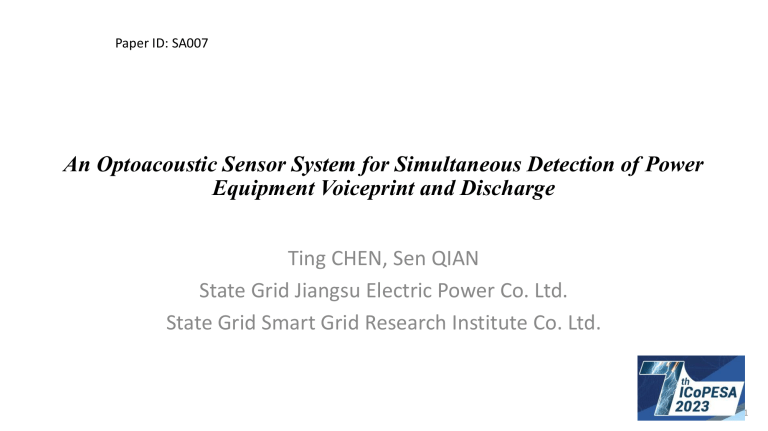
Paper ID: SA007 An Optoacoustic Sensor System for Simultaneous Detection of Power Equipment Voiceprint and Discharge Ting CHEN, Sen QIAN State Grid Jiangsu Electric Power Co. Ltd. State Grid Smart Grid Research Institute Co. Ltd. 1 Content 1 Background 2 Methods 3 Results 4 Conclusion Background Acoustic signals can carry information about the potential defects of power equipment. A transformer can hum differently depending on different states. A circuit breaker emits different sound when its components are defected. HV Bushing Conservator Gauge Gas Relay Hoise LV Bushing HV Lead LV Lead Cooler Loosen screw Winding Tank Fatigued spring Corona discharge Oil Core Contact Transformer’s sound feature under different states Pole Drive Base 3 Operation Mechanism Sources:Luo. Research on Typical Defects Recognition of Dry-Type Transformer Based on Voiceprint. North China Electric Power University Background Vibroacoustic sensors are widely used, such as microphone recording the sound of transformers and circuit breakers. Ultrasonic sensors are also used for partial discharge ultrasonic detection. Audible voiceprint Partial discharge ultrasonic detection Vibration PD ultrasonic detection (airborn) Because of size and cost, they are mainly deployed for condition monitoring of crucial power equipment. It is necessary to develop an acoustic sensor system that can be mounted 4 on the surveillance robot. Background The surveillance robot widely used in substation generally carry an visible camera and an infrared camera. In this research, we designed a prototype of an optoacoustic sensor system consisting of wideband micro-electro-mechanical-system (MEMS) microphones and a visible CMOS image sensor. The surveillance robot therefore can also sense the acoustic signals of the power equipment to find the potential faults which are difficult for visible and infrared camera to detect. 5 Content 1 Background 2 Methods 3 Results 4 Conclusion Methods The optoacoustic sensor system consists of two parts, i.e. the optoacoustic sensing array and the signal processing unit. The optoacoustic sensing array consisted of 64 off-the-shelf MEMS microphones. An FPGA drove the visible optical sensor and microphones. Knowles, SPH0641lU4H The signal processing unit processed the detected audio and video streams for voiceprint and ultrasonic discharge detection. 7 Methods The layout of the microphones are important for the design. Generally, a larger number of microphones could lead to better resolution. However, it also demands more resources for PDM demodulation. The -6 dB resolution angles were 11º at 5 kHz, 2.7 º at 20 kHz, and 1.1º at 50 kHz. Microphone layout Response to acoustic waves To balance the resolution and demodulation resources, we adopted 64 MEMS microphones laid in a multi-spiral arrangement, which offered a balanced response in far-field and near-field cases. 8 Methods A signal processing framework is laid. FIR lowpass filter was used to extract the voiceprint. FIR hipass filter was used to extract the discharge acoustic emission. mic1 mic2 mic3 Received signals Sum of received signals mic1 mic2 mic3 Received signals (delayed) Principle of D&S Beamforming Sum of delayed signals D&S beamforming was crucial to obtain the denoised waveform and acoustic field distribution. 9 Then the acoustic image can be obtained by overlaying the acoustic map on the visible photo. Methods A testing platform to verify the proposed design. Wideband audio connected to a waveform generator emitted ultrasonic pulses to simulate the discharges. Another laptop played back the recorded sound of the power transformer during switching. Chessboard calibration was performed in order to get the parameters of the visible sensor, so the space relationship between the acoustic map and the visible photo can be determined. 10 Content 1 Background 2 Methods 3 Results 4 Conclusion Results An excerpt of the raw waveform detected by the 1st microphone and its spectrogram indicates that the wave packet from 0.6 to 0.8 s was the power transformer’s switching sound. Only 13 ultrasonic pulses can also be seen on the temporal waveform. Temporal waveform of 1st mic Spectrogram The voiceprint of the transformer switching and ultrasonic pulses can be identified with better clearness by using the spectrogram 12 Results The signal processing framework used the FIR lowpass filtering to reject the ultrasonic pulses. Then D&S was used to improve the signal-to-noise ratio of the voiceprint of transformer’s switching. Original waveform Denoised voiceprint The SNR (amplitude of voiceprint to amplitude of noise level) was 3 before denoising and 7 after denoising. 13 Results The signal processing framework used the FIR hipass filtering to reject the sound of the transformer’s switching. Then D&S was used to improve the signal-to-noise ratio of the ultrasonic pulses. Original waveform Denoised ultrasonic pulses Significant SNR improvements can be seen. The 20 ultrasonic pulses can be easily identified on denoised waveform in contrast to the original waveform. 14 Results D&S algorithm can obtain the acoustic field distribution. Then acoustic images can be obtained by overlaying the acoustic field distribution on the visible photo. Visible photo Acoustic field distribution Ultrasonic pulse location Voiceprint location The resolution was better for higher frequency acoustic signals, which agreed with the previous 15 simulation of mic array to acoustic waves of different frequencies. Content 1 Background 2 Methods 3 Results 4 Conclusion Conclusions • An optoacoustic sensor system consisting of wideband MEMS mics and visible imaging sensor was designed, which can detect both the audible voiceprint of power equipment operation and ultrasonic emission due to discharge. • FIR filtering and delay-and-sum beamforming can significantly improve the SNR of the wanted signal and reject the unwanted interference. • The location of the acoustic sources can be located by the acoustic imaging obtained by beamforming. • Future efforts are needed to test its performance when mounting on surveillance robot. 17



